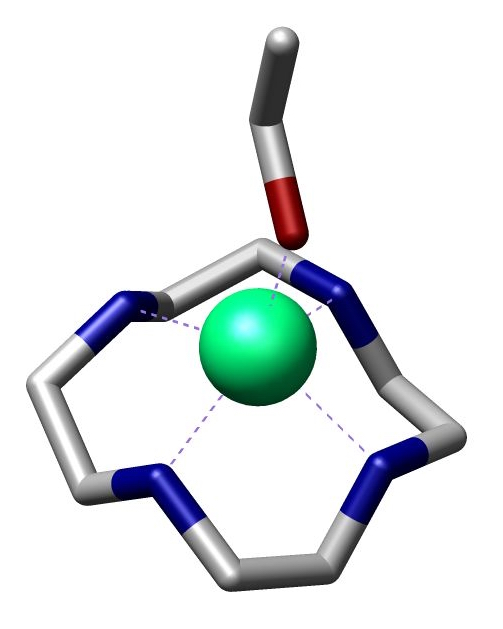Cyclen on:
[Wikipedia]
[Google]
[Amazon]
 Cyclen (1,4,7,10-tetraazacyclododecane) is a
Cyclen (1,4,7,10-tetraazacyclododecane) is a
 Cyclen (1,4,7,10-tetraazacyclododecane) is a
Cyclen (1,4,7,10-tetraazacyclododecane) is a aza-crown ether
In organic chemistry, an aza-crown ether is an aza analogue of a crown ether (cyclic polyether). That is, it has a nitrogen atom (amine linkage, or ) in place of each oxygen atom (ether linkage, ) around the ring. While the parent crown ethers ...
with the formula (CH2CH2NH)4. It is a white solid.
Synthesis
Some syntheses exploit the Thorpe-Ingold effect to facilitate ring-formation. Illustrative is the reaction of the deprotonated tosylamides with ditosylate
In organic chemistry, a toluenesulfonyl group (tosyl group, abbreviated Ts or Tos) is a univalent functional group with the chemical formula –. It consists of a tolyl group, –, joined to a sulfonyl group, ––, with the open valence on s ...
s:
:TsN(CH2CH2NTsNa)2 + TsN(CH2CH2OTs)2 → (TsNCH2CH2)4
The resulting macrocycle can be deprotected with strong acid. Base gives the tetramine.
High dilution conditions result in a low reaction rate penalty and this disadvantage is removed in an alternative procedure starting from triethylenetetraamine and dithiooxamide to a bisamidine – also a bis(imidazoline
Imidazoline is a class of heterocycles formally derived from imidazoles by the reduction of one of the two double bonds. Three isomers are known, 2-imidazolines, 3-imidazolines, and 4-imidazolines. The 2- and 3-imidazolines contain an imine
In ...
) – followed by reduction and ring expansion with DIBAL
Diisobutylaluminium hydride (DIBALH, DIBAL, DIBAL-H or DIBAH) is a reducing agent with the formula (''i''-Bu2AlH)2, where ''i''-Bu represents isobutyl (-CH2CH(CH3)2). This organoaluminium compound is a reagent in organic synthesis.
Properties
Lik ...
.
:
In one study cyclen is covalently
A covalent bond is a chemical bond that involves the sharing of electrons to form electron pairs between atoms. These electron pairs are known as shared pairs or bonding pairs. The stable balance of attractive and repulsive forces between atom ...
bonded through a propylene
Propylene, also known as propene, is an unsaturated organic compound with the chemical formula CH3CH=CH2. It has one double bond, and is the second simplest member of the alkene class of hydrocarbons. It is a colorless gas with a faint petrole ...
molecular spacer to adenine
Adenine () ( symbol A or Ade) is a nucleobase (a purine derivative). It is one of the four nucleobases in the nucleic acid of DNA that are represented by the letters G–C–A–T. The three others are guanine, cytosine and thymine. Its derivati ...
and chelated
Chelation is a type of bonding of ions and molecules to metal ions. It involves the formation or presence of two or more separate coordinate bonds between a polydentate (multiple bonded) ligand and a single central metal atom. These ligands are ...
with zinc
Zinc is a chemical element with the symbol Zn and atomic number 30. Zinc is a slightly brittle metal at room temperature and has a shiny-greyish appearance when oxidation is removed. It is the first element in group 12 (IIB) of the periodi ...
diperchlorate. This complex is able to selectively bind uracil
Uracil () (symbol U or Ura) is one of the four nucleobases in the nucleic acid RNA. The others are adenine (A), cytosine (C), and guanine (G). In RNA, uracil binds to adenine via two hydrogen bonds. In DNA, the uracil nucleobase is replaced by ...
and uridine
Uridine (symbol U or Urd) is a glycosylated pyrimidine analog containing uracil attached to a ribose ring (or more specifically, a ribofuranose) via a β-N1-glycosidic bond. The analog is one of the five standard nucleosides which make up nuclei ...
in a 1:2 ratio both through the adenine part and cyclen part of the molecule as evidenced by mass spectrometry
Mass spectrometry (MS) is an analytical technique that is used to measure the mass-to-charge ratio of ions. The results are presented as a ''mass spectrum'', a plot of intensity as a function of the mass-to-charge ratio. Mass spectrometry is use ...
.
See also
*Cyclam
Cyclam (1,4,8,11-tetraazacyclotetradecane) is an organic compound with the formula (NHCH2CH2NHCH2CH2CH2)2. Classified as an aza-crown ether, it is a white solid that is soluble in water. As a macrocyclic ligand, it binds strongly to many transitio ...
References
Further reading
* {{cite journal , author1=Suchý, M. , author2=Hudson, R. H. E. , journal = Eur. J. Org. Chem. , volume = 2008 , year = 2008 , pages = 4847–4865 , title = Synthetic Strategies Toward ''N''-Functionalized Cyclens , doi = 10.1002/ejoc.200800636 , issue = 29 Ethyleneamines Macrocycles Chelating agents Nitrogen heterocycles Secondary amines